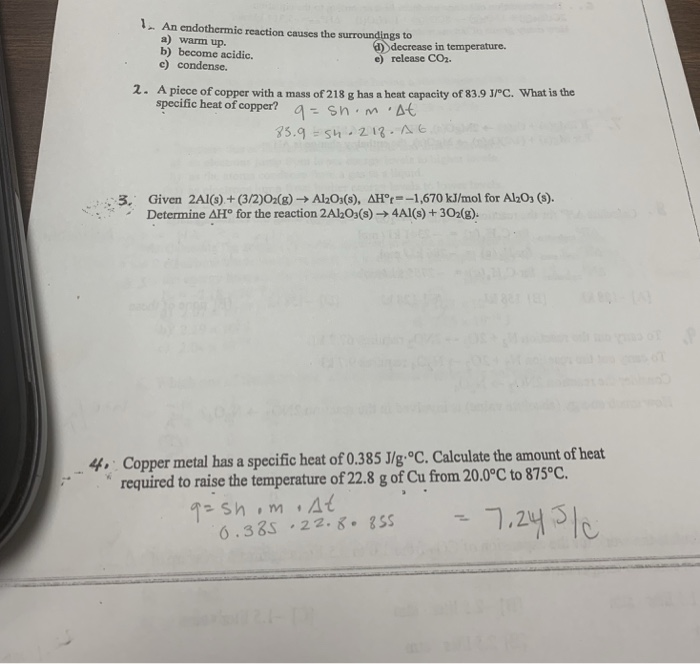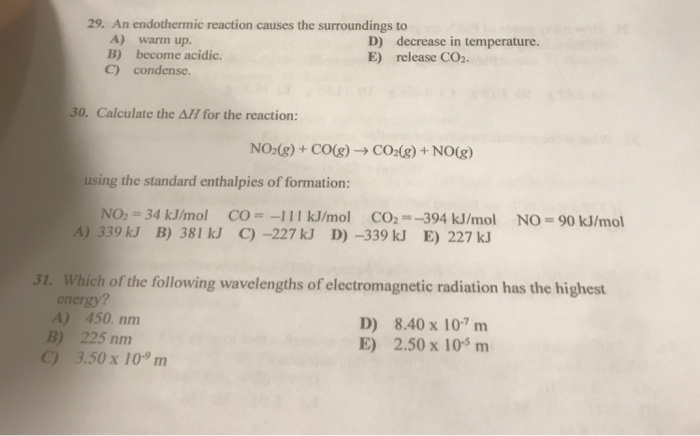Answer 1 of 2. 34 kJmol CO -1 1 1 kJmol 339 kJ B 381 kJ C-227.

Solved 1 An Endothermic Reaction Causes The Surroundings To Chegg Com
An endothermic reaction causes the surroundings to.

. Endothermic reactions result in an overall positive heat of reaction q r x n 0. Endothermic reaction feel cold because the heat or energy is absorbed from the environment. Most endothermic reactions are not spontaneous Standard Enthalpy Change of Reaction - The difference between the products and the.
42522 957 PM Assignment Print View 31. E release CO 2. Asked Jun 26 2017 in Chemistry by YeaaBuddy.
The reaction causes the temperature of the resulting solution to fall below. How can the enthalpy change of a reaction be determined mathematically. If the bonds formed are stronger than the bonds broken the reaction is exothermic.
6CO2 6 H2O heat --- C6H12O6 6O2. Endothermic reactions are chemical processes in which the reactants absorb heat from the environment to produce products. When HCl g reacts with NH3 g to form NH4Cl s according to the following equation energy is released into the surroundings.
Absorption of heat increases the entropy in the system. Decrease its temperature B. Exothermic and endothermic reactions cause energy level differences and therefore differences in enthalpy Δ H.
An endothermic reaction causes the surroundings to A warm up. Up to 24 cash back Endothermic Reaction - A reaction that causes the temperature of the surroundings to decrease. Energy is used up in the reaction as the enthalpy of the products is greater than the enthalpy of the reactants.
So when ice consumes energy it allows the transition to occur. NO2 g CO g CO2 g NO g using the standard enthalpies of formation. In an endothermic reaction heat is transferred from the system to the surroundings.
D decrease in temperature. An endothermic reaction gives off heat to the surroundings. References Multiple Choice Difficulty.
An exothermic reaction causes the surroundings to A. Which of these processes is endothermic. An endothermic reaction causes the surroundings to.
2 Cooking an egg. An endothermic reaction is one that absorbs heat energy from the surrounding environment. Plants absorb heat energy from sunlight to convert carbon dioxide and water into glucose and oxygen.
Which of the following is the highest energy consumption by source. The ice cube needs heat to melt. B become acidic C condense.
An endothermic reaction occurs when the temperature of an isolated system decreases while the surroundings of a non-isolated system gains heat. 4 rows Endothermic reactions are chemical reactions in which the reactants absorb heat energy from. Calculate the Δ for the reaction.
A cold pack is snapped and the chemical reaction causes the pack to feel cold. 309 2CH OHg 2COg 2H2Og HOg H201 H0s H201 D. Endothermic reactions require energy from the external environment preferably in the form of heat for the reaction to take place.
An endothermic reaction causes the surroundings to A warm up decrease in temperature B condense C D become acidic. Award232 out of 232 points Which type of system may transfer energy but not. It is all about bond breaking bond forming and bond strength.
This makes the surrounding feel cold. Which kind of reaction is this. An endothermic reaction causes the surroundings to A warm up.
This makes melting ice cubes an endothermic reaction. Exothermic reactions cause the temperature of the surroundings to increase eg. Why is melting ice cubes an endothermic reaction.
Endothermic reactions cause the temperature of the surroundings to decrease. At the moment of bond formation the endothermic reaction forms a shorter stronger bond that contains more energy than before the reaction. Heat energy is absorbed from the pan to cook the egg.
This is an exothermic reaction because the surroundings took energy from the system. Two aqueous solutions are both at room temperature and are then mixed in a coffee cup calorimeter. Chemistry questions and answers.
An endothermic reaction gives off heat to the surroundings. This is an endothermic reaction because the surroundings took energy from the system. When the heat is absorbed the temperature of the surrounding decreases.
This is an exothermic reaction because the system took energy. Consider that in a chemical reaction bonds in the reactants are broken and bonds in the products are formed. Answer 1 of 3.
An endothermic reaction needs external heat energy to break the intermolecular force present in the bond. An endothermic reaction causes the surroundings to warm up. 0g 2H2g 2H2Og C.
C condense D E decrease in temperature. To store the higher energy in the bond and actually make the bond the vibrating molecules in. These reactions cause a cooling effect by lowering the temperature of the surrounding environment.
Since endothermic reactions attract heat from their environment they will in general cause their surroundings to subtly drop in temperature. Therefore an ongoing endothermic reaction will.

Solved 72 An Endothermic Reaction Causes The Surroundings Chegg Com

Solved 29 An Endothermic Reaction Causes The Surroundings Chegg Com

Solved 7 An Endothermic Reaction Causes The Surroundings Chegg Com
0 Comments